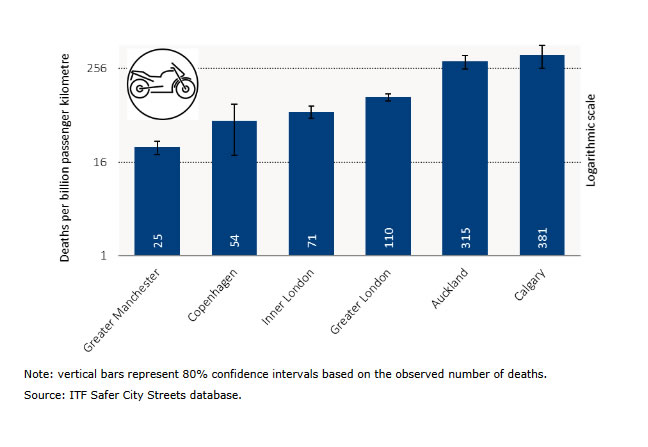 The ITF report “Monitoring Progress in Urban Road Safety” 2022 update – pdf 4.14mb or….. Flogging a Dead Horse!
The ITF report “Monitoring Progress in Urban Road Safety” 2022 update – pdf 4.14mb or….. Flogging a Dead Horse!
The ITF authors of this report can spin these fatalities with other factors, so not only billion kilometres travel or population or even how many riders have a licence and how many bikes are registered for use etc, but what is possibly more relevant than these trends or extrapolation of figures, is that they do not explain the reasons behind the collisions that lead to injuries – slight, serious or a fatality, because as we all know, each road traffic collision is unique.
Furthermore, due to the different methodologies of gathering data throughout the world, as suggested in the report, it is difficult to grasp the overall problem of collision fatalities which is exacerbated by the use of million (or billion) kilometres (or miles) travelled as a means of identifying risk. The reason for this is that for example in Northern European countries, PTW usage tends to be far less than car usage and seasonal and therefore incompatible with other forms of transport and with PTW usage in southern European and Low Income countries.
The response from the ITF report may be that statistics are needed to get an understanding of what is happening and we would be the first to agree. However it’s the analysis of these statistics which requires more in-depth consideration, not commenting that motorcycles should be avoided as they did on page 25
“The safety of riding motorcycles and scooters varies significantly across cities. Greater Manchester is a relatively safer city to drive a powered two-wheeler when compared to other cities that provided data. In comparison with risk levels observed for walking and cycling, the risk of riding a motorcycle or a moped is very high. This underlines the importance of providing good public transport, cycling and walking alternatives for equitable mobility.”
Then on the next page, presenting their data of motorcycle deaths based on billion kilometres travelled (as seen in the screenshot above).
For example, if the majority of motorcyclists crash because of panic braking, isn’t the cause and effect relevant? Isn’t it important to know that simply looking at a set of numbers and then using a set of dodgy surveys (which is what is typically used to calculate billion kilometres travelled) to draw conclusions, doesn’t really help to understand what happens.
Apart from appeasing a few politicians, what do the ITF authors hope to achieve by informing us that the distance ridden to the moon and back is relevant to the reduction of casualties?
The important issue here is that this is yet another report and follows on from a workshop on motorcycle safety which was a series of virtual meetings 9–23 June 2021.
The workshop was co-organised by the International Transport Forum (ITF), the Swedish Transport Administration, the International Motorcycling Federation (FIM), the motorcycle manufacturers associations (IMMA and ACEM), and the Swedish National Road and Transport Research Institute (VTI).
The workshop was a follow-up of the Third Global Ministerial Conference on Road Safety, held in Stockholm in February 2020, but it also built on a previous workshop in 2008 in Lillehammer and the 2015 ITF research report “Improving Safety for Motorcycle, Scooter and Moped Riders”.
The first Motorcycle workshop held in 2008 was the best example of joint collaboration between the motorcycling community and organisations such as the ITF (then ECMT)/OECD. With the leadership of Jack Short, then General Secretary of the ECMT and the Federation of European Motorcyclists Associations, the motorcycle industry and others, the pace was set to improve conditions globally for motorcyclists.
Sadly nothing happened, the report was never used, nor was the outcome of the 2015 ITF research report on motorcycle safety (1).
With regards the 2021 report “Riding in a safe system – workshop on safety for powered-two-wheelers – Final report from a workshop held on 9–23 June, 2021”. The report was published in December 2021. However, it appears that this report is intended to not see the light of day. In spite of asking various participants on numerous occasions, the response was silence (2). So all considered, lots of follow ups and no results. It kind of makes you wonder why they bother, or does it? After all, we all need jobs and I suspect some of the people involved in these reports are well paid. It’s a real shame that their time is not used more wisely.
To conclude and get back to the issue of dodgy statistics. The gaggle of “experts” who blight our society with their questionable data and opinions are not saving lives. There are a lot of good reports and studies out there, written by people who actually know what they are talking about (3).
Flogging a dead horse which is what the authors of the ITF report are effectively doing are just making matters worse. Perhaps they would benefit from reading the “Dead Horse Theory”, it is quite enlightening (4).
Just to make a point – if we haven’t already done so, you may want to watch the video of two Australian riders who try to understand the often used statistic that motorcyclists are so many times more likely to be killed/ seriously injured and so many times more likely to be killed than drivers per 100 million kilometres ridden – in this case 38 times more likely.
Elaine Hardy PhD
Original article on LinkedIN
References:
1. ITF/OECD Working Group 1 On The Safety Of Powered Two-Wheelers – Final Report – 2014 pdf 261kb
2. International Report – Light Of Day
3, A list of reports and studies regarding motorcycles and motorcycle safety here: Motorcycle Minds Virtual Library
4. Dead Horse Theory – Elaine Hardy PhD – On LinkedIn


Leave a Reply